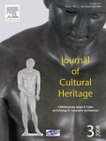Comparison of adsorbent materials for acetic acid removal in showcases
 |
António João Cruz, João Pires, Ana P. Carvalho, M. Brotas de Carvalho, "Comparison of adsorbent materials for acetic acid removal in showcases", Journal of Cultural Heritage, 9(3), 2008, pp. 244-252 doi:10.1016/j.culher.2008.03.001 |
|
|
| Abstract | The effect of selected adsorbents in the preservation of objects of cultural value was studied. For this, two adsorbents that, in previous studies, revealed to be effective in the adsorption of acetic (ethanoic) acid vapors (activated carbon RB4 and NaX zeolite), were used in tests where lead sensors were exposed to the vapors of an acetic acid aqueous solution (corresponding to a concentration of acetic acid in atmosphere of about 160 mg m-3). The protection provided by the adsorbents was measured through the comparison of the increase of the sensor mass in the presence and in the absence of the adsorbents. The RB4 activated carbon has shown to be the most advantageous adsorbent. With amounts corresponding to 3.3 kg per m3 of the volume showcase, it originated a decrease of the lead alteration of 50-70 % for some months. It was verified that it is possible to recycle the RB4 with good yield by heating it at 120 °C during 24 h. It was not detected any decrease of efficacy after one cycle of use. The extension of the regeneration suggests that it will be possible to reuse the material several times. |
| Editora | URL |
| Ver | |
| Academia | Researchgate | |
| Importar | RIS | Endnote |